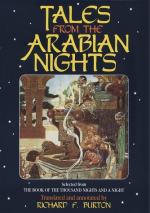[FN#278] For the “Tak” or “Takah” = the little wall-niche, see vol. vii. 361.
[FN#279] In the French and English versions the coin is a bit of lead for weighting the net. For the “Paysa” (pice) = two farthings, and in weight = half an ounce, see Herklot’s Glossary, p. xcviii.
[FN#280] In the text “bilisht” = the long span between thumb-tip and minimus-tip. Galland says long plus d’une coudee et gros a proportion.
[FN#281] For the diamond (Arab. “Almas” from {Greek}, and in Hind. “Hira” and “Panna”) see vols. vi. 15, i. ix. 325, and in latter correct, “Euritic,” a misprint for “dioritic.” I still cannot believe diamond-cutting to be an Indian art, and I must hold that it was known to the ancients. It could not have been an unpolished stone, that “Adamas notissimus” which according to Juvenal (vi. 156) Agrippa gave to his sister. Maundeville (A.D. 1322) has a long account of the mineral, “so hard that no man can polish it,” and called Hamese ("Almas?"). For Mr. Petrie and his theory, see vol. ix. 325. In most places where the diamond has been discovered of late years it had been used as a magic stone, e.g., by the Pages or medicine-men of the Brazil, or for children’s playthings, which was the case with the South-African “Caffres.”
[FN#282] These stones, especially the carbuncle, which give out dight in darkness are a commonplace of Eastern folk-lore. For luminous jewels in folk-lore, see Mr. Clouston (i. 412): the belief is not wholly extinct in England, and I have often heard of it in the Brazil and upon the African Gaboon. It appears to me that there may be a basis of fact to tints fancy, the abnormal effect of precious stones upon mesmeric “sensitives.”
[FN#283] The chimney and chimney-piece of Galland are not Eastern: the H. V. uses “Bukhari” = a place for steaming.
[FN#284] i.e. “Rachel.”
[FN#285] In the text “lakh,” the Anglicised “lac” = 100,000.
[FN#286] This use of camphor is noted by Gibbon (D. and F. iii. 195).
[FN#287] “Ab o hawa” = climate: see vol. ii. 4.
[FN#288] Galland makes this article a linen cloth wrapped about the skull-cap or core of the turban.
[FN#289] Mr. Coote ( loc. cit. p. 185) is unable to produce a puramythe containing all of “Ali B ba;” but, for the two leading incidents he quotes from Prof. Sakellarios two tales collected in Cyprus One is Morgiana marking the village doors (p. 187), which has occurred doubtless a hundred times. The other, in the “Story of Drakos,” is an ogre, hight “Three Eyes,” who attempts the rescue of his wife with a party of blackamoors packed in bales and these are all discovered and slain.
[FN#290] Dans la fort, says Galland.
[FN#291] Or “Samsam,” The grain = Sesamum Orientale: hence the French, Sesame, ouvre-toi! The term is cabalistical, like S£lem, S£lam or Sh£lam in the Directorium Vit Human of Johannes di Capu: Inquit vir: Ibam in nocte plenilunii et ascendebam super domum ubi furari intendebam, et accedens ad fenestram ubi radii lune ingrediebantur, et dicebam hanc coniurationem, scilicet sulem sulem, septies, deinde amplectebar lumen lune et sine lesione descendebam ad domum, etc. (pp. 24-25) par Joseph Derenbourg, Membre de l’Institut 1re Fascicule, Paris, F. Vieweg, 67, Rue de Richelieu, 1887.




